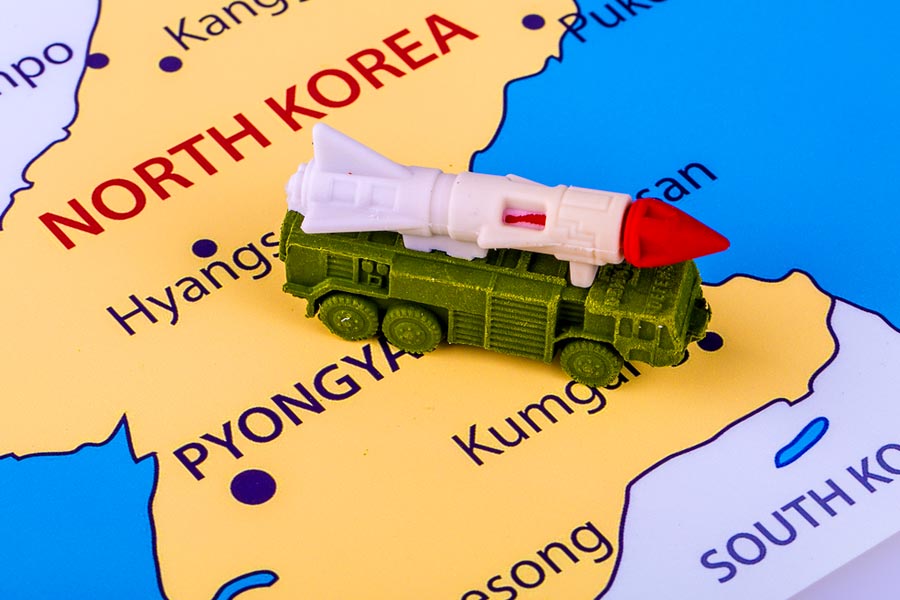A suspected hypersonic missile launched by North Korea exploded in flight on Wednesday, South Korea's military said, as North Korea protests the regional deployment of a US aircraft carrier for a military drill with South Korea and Japan.
Later Wednesday, South Korea conducted live-fire drills along its disputed western sea boundary with North Korea, its first since it suspended a 2018 agreement with the North aimed at reducing front-line military tensions in early June.
The North Korean missile was launched at about 5:30 am and was aimed toward the North's eastern waters before the failure, South Korea's Joint Chiefs of Staff said. Missile fragments were scattered in the water up to 250 kilometres from the launch site near North Korea's capital, it said. No damage was immediately reported.
The Joint Chiefs of Staff said it believes the weapon was a solid-fuelled hypersonic missile. The launch generated more smoke than normal launches, possibly because of an engine fault, it told South Korean reporters at a background briefing. The contents of the briefing were shared with foreign media.
In a three-way phone call, senior diplomats from South Korea, the US and Japan condemned the missile launch as a violation of UN resolutions and agreed to maintain close coordination in response to North Korean threats, according to South Korea's Foreign Ministry.
North Korea has performed a series of hypersonic missile tests since 2021 in an apparent effort to acquire an ability to penetrate its rivals' missile defence shields. Foreign experts question whether the missiles have achieved their desired speed and maneuverability during the test flights.
In recent years, North Korea has also been developing more missiles that use solid propellants, Launches of such missiles are harder to detect than liquid-propellant missiles, which must be fuelled before liftoff.
Wednesday's missile test came as the rival Koreas are engaged in Cold War-style psychological warfare using balloons and loudspeaker broadcasts.
South Korea said North Korea launched large balloons carrying trash across their border Tuesday night for the sixth time since late May. About 100 balloons with bags of paper waste reportedly fell in South Korean territory.
The balloons resulted in the suspension of takeoffs and landings at South Korea's Incheon International Airport, about an hour's drive from the border, for three hours early Wednesday, in the second such disruption since the North's balloon launches began on May 28, according to South Korean aviation authorities.
North Korea says it is responding to balloons launched by South Korean activists that carried political leaflets into the North. On June 9, South Korea briefly conducted propaganda broadcasts from loudspeakers along the border for the first time in years in response to the North Korean balloons. South Korea's military said Monday it is ready to turn on its loudspeakers again.
On Wednesday, South Korean forces on front-line islands fired 290 artillery and missile rounds into the waters near the Koreas' western sea boundary, the site of several bloody naval skirmishes since 1999, the South Korean marine corps said. It said South Korea will regularly conduct firing drills there.
Such firing exercises were prohibited under the 2018 tension-easing deal with North Korea, which required both countries to cease all hostile acts along their land and sea borders.
The deal had already been in danger of collapsing in recent months, with the two Koreas firing artillery rounds near the sea boundary in January and taking other steps that violated it.
Also Wednesday, South Korea and the US flew 30 advanced fighter jets as part of joint drills this week.
The aircraft carrier USS Theodore Roosevelt arrived in South Korea on Saturday, and North Korean Vice Defence Minister Kim Kang Il on Monday called its deployment “reckless” and “dangerous.” North Korea has previously described major US-South Korean drills as invasion rehearsals and has reacted with missile tests.
South Korean President Yoon Suk Yeol visited the vessel on Tuesday, becoming the first sitting South Korean president to board a US aircraft carrier since 1994. Yoon told American and South Korean forces on the carrier that their countries' alliance is the world's greatest and can defeat any enemy. He said the US carrier would depart Wednesday for the South Korea-US-Japan drill, dubbed “Freedom Edge.”
South Korean officials said the training aims to strengthen the three countries' capability to respond to North Korea's evolving nuclear threats at a time when the North is advancing its military partnership with Russia.
During a summit in North Korea's capital last week, North Korean leader Kim Jong Un and Russian President Vladimir Putin signed a deal requiring each country to provide aid to the other if it is attacked and vowed to boost other cooperation. Analysts say the accord represents the strongest connection between the two countries since the end of the Cold War.
The United States and its partners believe North Korea has been providing Russia with conventional arms for its war in Ukraine in return for military and economic assistance.
North Korea's missile launch on Wednesday was its first weapons demonstration since Kim Jong Un on May 30 supervised the firing of nuclear-capable multiple rocket launchers to simulate a preemptive attack on South Korea.
Since 2022, North Korea has sharply increased its weapons tests to boost its nuclear attack capabilities in response to what it calls a deepening US military threat. Foreign experts say North Korea eventually aims to use its larger nuclear arsenal to wrest greater concessions from the US when talks resume between them.











